
24 Nov Open and Attentive
The temperature gauge in my truck reads 1 degree Fahrenheit as we pass through Roosevelt’s Arch at the northwest entrance to Yellowstone National Park. A full moon hangs low to the west over Electric Peak, opposite the trajectory of the rising sun. The reflected sunlight off the orbiting space ball illuminates the snowy landscape at the blue hour of a new day — how surreal. My companions, Ben and Forrest, are fellow naturalists along for a wintery outing with no agenda for the day — just curious minds with keen eyes in a beautiful part of the world.

Ben Lizdas pauses as he looks out across the Yellowstone River in search of a year-round bird resident, the American dipper (Cinclus mexicanus).
There’s one constant when approaching Yellowstone from any angle: it’s always uphill. And in the winter, it’s cold. The dormant supervolcano has created a high-elevation plateau amidst the tall peaks of the Rocky Mountains. This means more snow as you travel deeper into the park. Most of the animals and people that make a living in the region vacate the park by hoof, wing, or vehicle this time of year. The human visitation in winter falls below 5 percent of the park’s approximately 4 million people who come annually to enjoy its offerings. We are grateful for the quiet as we wind our way higher along the snowy slopes of the park’s northern range.

The fur of the American bison (Bison bison) is well suited for winter’s chill.
I’ve spent my adult life immersed in the wild places of our extradentary planet, working on all seven continents as a biologist, photographer, videographer, and writer. Many of my endeavors required hard-earned imagery, often as I tried to get as close to animals as they would tolerate. There is power in proximity. I want the viewers of my work to experience that power and for it, in turn, to spark their passion. So I’ve worked for months — sometimes years — to try to convey the essence of a place or an animal through photographs, films, and essays. But it’s always an impossible pursuit. How can two-dimensional works ever capture three-dimensional movement, texture, temperature, sound, smell, and geology? There is no substitute for being engulfed by unbridled nature, to be there and to pay attention.
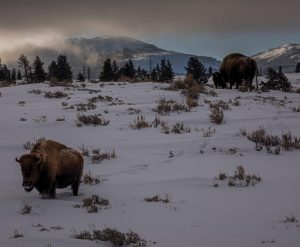
Bison have strong necks and shoulders that allow them to push through deep snow to access grasses in the heart of winter.
More often these days, I’m drawn to the quiet observation of places and animals, to sit or walk, senses wide open, taking in all the natural stimulus that’s present, observing the endless threads that tie it all together. Each animal, plant, or landscape is in relationship with everything else around it — even with our solar system through photosynthesis. The only requirement of such observation is to bear witness, to learn, to remember. And to share. Without the pressure to produce powerful imagery, I’m free to observe wolves playing miles away through a spotting scope, never needing to get closer. I can watch the passing of a Clark’s nutcracker on the wing through binoculars and ponder its relationship to sleeping grizzly bears. The natural world is a teacher with boundless lessons to bestow; all we must do is listen.
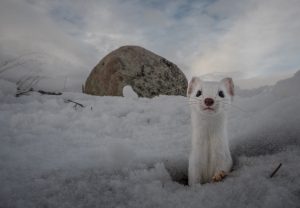
A short-tailed weasel emerges from a rodent’s hole in the Boulder River valley in Montana. In winter, these weasels turn all white except for a little black tip on their tails.
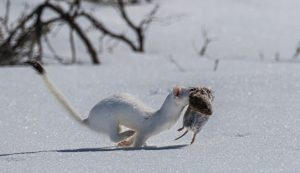
A long-tailed weasel sprints across the open snow, from one hiding place to another, with a meadow vole in its mouth. Neither of these mammals hibernate in winter and can live in the subnivean zone between the snow and the ground.
Winter offers one of the more magical glimpses into the lives of wild animals through their tracks left in the snow. Many species are nocturnal, shy, or survive at such low densities — cougars, pine martens, wolverines, deer mice, and great gray owls — that seeing them at all is a rarity. All these species are active throughout the long northern winters, yet I go months or even years without spotting one. But I see their tracks every single winter, and, in following those tracks, I get a glimpse into how these animals think and behave. Each track offers a little story. With the help of tracking guidebooks or a workshop, the silence of the winter world is enlivened by these traces of animals sharing their stories in the snow.
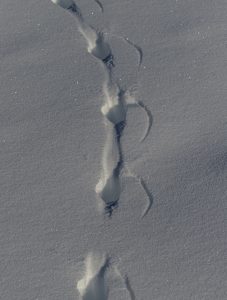
The tracks of a weasel traveling with a rodent in its mouth contains a curved line on the right side of the track that is made by the dead rodent’s tail.
While on a walk, we stop to inspect recently disturbed snow. The tracks are small and look more like strange shapes than actual footprints. But they tell us an interesting tale, or perhaps I should say tails in this case. The tracks are uniform and relatively straight, showing both the animal’s footfalls and some of its body and tail imprinted in the snow. If you took your index and middle fingers and made a vertical imprint, like two side-by-side legs, and then hopped your two fingers forward through the snow about a foot apart, you’d be closely mimicking the track of one of the Rocky Mountain’s most successful predators: the weasel.
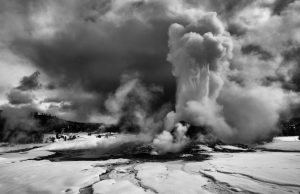
Yellowstone National Park sits atop an active supervolcano and is home to more than half of the world’s hydrothermal features. Castle Geyser, pictured here, erupts every 12 to 14 hours.
What is different about this set of weasel tracks is that we’re reading two different tail marks in the snow. There is a faint sweep within the line of the usual weasel’s track — made from its own tail — but there is also a distinct tail sweep on the outside of the tracks, seemingly floating. The story we’re reading from these tracks tells us this weasel made a successful kill, and the seemingly floating second tail mark is from its prey. Weasels will carry their prey in their mouth, and in this case, a mouse’s tail was likely brushed across the snow as the weasel bounded to a hiding spot to safely feed.
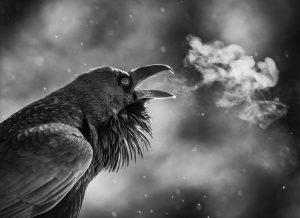
Ravens can spend the entire winter traveling long distances in search of food. Pairs are often heard communicating with each other on chilly winter mornings.
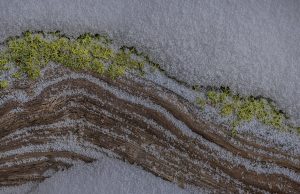
Commonly known as wolf lichen (Letharia vulpina), this bright green lichen grows on conifers, like this juniper root in Yellowstone.
There are three species of small weasels found here, some with wide distributions across North America and one that even dips into South America. From smallest to largest, they are the least, short-tailed, and long-tailed. The least weasel holds a special place in the world of meat-seeking mammals as the smallest four-legged carnivore on Earth (there are smaller carnivorous bats that fly). I’ve seen their tracks many times in winter and have found a few dead least weasels, but I have yet to see their 6- to 8-inch bodies streaking across the landscape. They can also be hard to spot due to their camouflage wardrobe change between summer and winter: They go from brown to white so that they blend into the landscape to avoid ending up prey themselves — often to winged predators. One of their evolved adaptations was the development of a black-tipped tail that just might confuse an aerial predator coming down to nab them. Only the least weasel lacks the black tip; perhaps its small size, speed, and agility are enough.
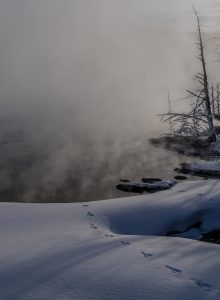
Tracks from the mountain cottontail rabbit (Sylvilagus nuttallii) skirt a thermal pool in Yellowstone.
Later, as we huddle into our thermal coats at Hellroaring Overlook in the middle of Yellowstone’s northern range, Ben narrates what he’s seeing through the spotting scope. Twenty-two wolves of the Junction Butte Pack are spread out across an open hillside, having a lazy and playful morning with full bellies after a successful hunt. “The gray one just chased off that raven,” Ben says. “It’s now chewing on an antler. The two black ones are chasing each other around a tree. Ah, this is so fun to watch.” We take turns peering through the scope. Some wolves are sunbathing in the subzero temperature while others take turns playing the age-old game of keepaway with an elk antler. They are miles away, but Ben, Forrest, and I are at attention, invigorated by our observations of this wild community. Even on a cold wintery day, we are warmed by our shared passion for the natural world and the gifts it has to offer us all.




No Comments